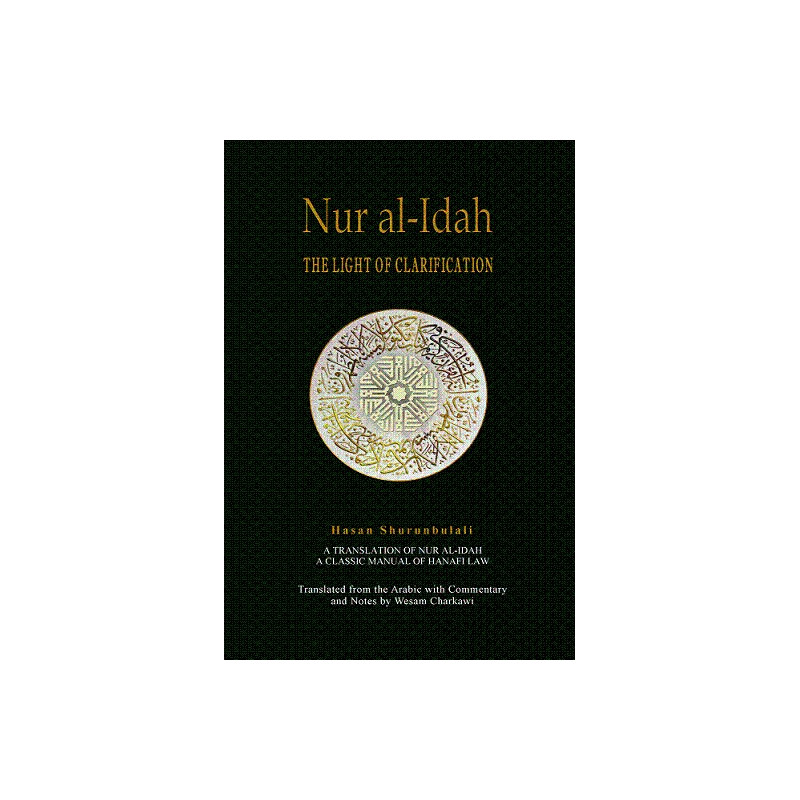




Godkendt webshop. Betal med kreditkort
 FAST fragt 35 kr. (GLS). Gratis fragt fra 499 kr.
FAST fragt 35 kr. (GLS). Gratis fragt fra 499 kr.
Mulighed for gratis afhentning.

Fuld 14 dages returret fra modtagelse af ordre
Nur al-Idah is a Hanafi text which includes vast areas of jurisprudence, namely, the rulings pertaining to worship. It leaves the student or general reader well prepared to deal with the majority of matters ranging from purification, prayer, funerals, zakah to hajj. It reveals in a small way as to why the Hanafi Madhhab is held in such high esteem from scholars all over the world. It is practical, sensible and can be used as a reference book. This book is based on the teachings of Abu Hanifa and his students, namely Imam Muhammad, Abu Yusuf and Zufar; and will provide the reader with a brief look as to why the Hanafi Madhhab is the most widely embraced in the world today.
Ahmad Ibn Hanbal said, If in any matter there is agreement between three people, then one pays no attention to the verdict of anyone who disagrees with them. Someone asked him, Who are they? He answered, Abu Hanifa, Abu Yusuf and Muhammad Ibn al-Hasan.'
The Nur al-idah is a classical text on sacred law, and for generations has been one of the most widely taught texts used to transmit Hanafi fiqh. Generations of scholars and layman alike have been taught the Nur al-idah, which gives them sufficient grounding in the basic masa’il they encounter daily.
The translation of Nur al-Idah is displayed in bold while the commentary and explanation, the majority of which is from Maraky al-Falah is written in plain text. It has been the translators attempt to prepare the text of Nur al-Idah in a manner that can be read independently without reading the commentary. However, commentary is essential for further explanations of the actual text and for this reason it entails views from other Hanafi sources such as al-Ikhtiyar and al-Hidayah, as well as the position of other schools, such as the Shafi’i Madhhab. This is intended to give the reader a broader perspective on matters and demonstrate the similarity between the various schools of thought.
Referencing the text with evidence, namely, with Quran or hadith has been given on most issues and that areas where it is not, is either due to qiyas (analogical reasoning) or because of its unanimous agreement on that particular issue. A translation may simplify many things, though this will still require the complete and concentrated attention of the reader. Also, many examples and explanatory notes have been included. These are, for the most part intended to clarify what might otherwise have been an obscure or ambiguous passage in the original or as a result of the translation.
The main Hanafi books, such as The Hashia of Ibn ‘Abidin, al-Hidayah and al-Mabsut were referred to, as well as consultation from some of the most eminent scholars. The text also includes sample examination questions in an effort to help the reader view the laws in a different light and to enable him to deal with legal rules in a practical way.
The author is Abu al-Ikhlas al-Hasan b. `Ammar b. `Ali b. Yusuf Shurunbulali he was born in in 994 A/H. He became a master of jurisprudence at the hands of Abdullah al-Nahriri and Muhammad al-Mahby. He studied at the prestigious seat of learning, al-Azhar, Cairo, under the patronage of some of the most eminent scholars of his time. He himself later became a scholar of great repute and a copious writer, whose works exceed fifty in number. The Shaykh passed away in 1069 A/H.
Imam Abu Hanifa is an-Nu’man Ibn Thabit, the great imam, born in 80 A.H. in Kufa during the Khalifa of Abdul Malik Ibn Marwan. Abu Hanifa assumed the role of a merchant. During this time, he was not linked to the field of knowledge and did not know the men acquainted with it. One day a religious scholar [ash-Sha‘bi] noticed Abu Hanifa’s intelligence and cleverness and advised him to pursue the field of knowledge and attend his gatherings where he could derive benefit from the opinions of the scholars. Ash-Sha‘bi said to him, I discern alertness and energy in you. This affected Abu Hanifa and caused him to adopt the advise and commence the pursuit of knowledge. He experienced the full Islamic culture of his age. He memorised the Quran, knew an extensive amount of hadith, grammar, literature and poetry. He then immersed himself to fiqh becoming of one the greatest scholars in Kufa.
Abu Hanifa quickly became known for his legal brilliance and problem solving and the strength of his arguments in directing those to the reality. Imam Malik was asked about Abu Hanifa in which he said I have not seen anyone like him, by Allah if he said that this pillar was made of gold, he would have brought an analogical proof proving the validity of his case. Imam Shafi‘i said [Whoever intends to become an ocean in the jurisprudence, then he should venture to Abu Hanifa. I have not known a faqih like him]. Equally, Imam Ahmad Ibn Hanbal would cry when remembering Abu Hanifa and would supplicate Allah’s mercy upon him. An-Nadhr said that (the people were sleeping with regards to jurisprudence until they were awoken by Abu Hanifa) (Allah be pleased with him and his companions)).
Produktinformation